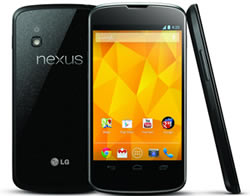Difference between Sony Xperia L and Nexus 4
Key difference: The Sony Xperia L is a mid-range smartphone. It features a 4.3-inch screen with a resolution of 854x480px and a scratch-resistant cover glass. It runs on Android 4.1 with a Dual-Core 1GHz Qualcomm MSM8230 chipset and 1 GB of RAM. The Nexus 4 is Google's fourth Nexus-branded Android smartphone. It was produced in collaboration with LG Electronics. The phone features a 1.5 GHz quad-core Snapdragon S4 Pro processor, 2 GB of RAM, and 8 or 16 GB of internal storage. The phone runs on the Android 4.2 (Jelly Bean) operating system, which was launched with the phone.
 Smartphones have taken over the world! It has become a trend, a necessity and a way of life. They have made it easier to do everything on the go, from e-mailing, video conferencing, to writing up a report or a project. There isn’t anything you cannot do these days with a smartphone. But alas, similar to all technological devices, the software and features start to become outdated as new features and software are developed and released. Hence, companies start to release newer models of smartphones.
Smartphones have taken over the world! It has become a trend, a necessity and a way of life. They have made it easier to do everything on the go, from e-mailing, video conferencing, to writing up a report or a project. There isn’t anything you cannot do these days with a smartphone. But alas, similar to all technological devices, the software and features start to become outdated as new features and software are developed and released. Hence, companies start to release newer models of smartphones.
Some of the latest new smartphones are the Sony Xperia SP and Sony Xperia L, both belonging to the Sony’s Xperia flagship. The Sony Xperia L is a mid-range smartphone. It features a 4.3-inch screen with a resolution of 854x480px and a scratch-resistant cover glass. It runs on Android 4.1 with a Dual-Core 1GHz Qualcomm MSM8230 chipset and 1 GB of RAM. It also has all the bells and whistles, including Wi-Fi, Bluetooth and 3G HSPA connectivity, as well as NFC support. The NFC is integrated with a one-touch connection to external displays in order to allow for big screen playback of videos or photos. The phone does not however have LTE capability.
Still, its saving grace has to be its 8 MP camera, which uses Sony's latest mobile Exmor RS sensor and offers a built-in HDR mode for both stills and video. The Exmor RS sensor is supposed to improved clarity and color reproduction, while the HDR mode will allow for better pictures in various different kinds of lights.
The phone is powered by a 1900mAh battery and has a battery STAMINA Mode for optimizing power consumption. The phone is available in three colors: white, black and red. It also has an LED light on the bottom of the phone that can be customized to blink different colors to indicate an incoming phone call, a missed call or text message. The light can also be programmed to blink in correspondence with the rhythm of the song played on the built in Sony Walkman music player.
The phone also comes with pre-installed Sony apps called Walkman, Album, and Movies. These are part of a pre-loaded software suite that allows for consuming and sharing a vast library of multimedia content.
 A number of these companies’ smartphones and tablets run on Android. Android is an open source software, which means that the code is freely available for modification and distribution by device manufacturers, wireless carriers and enthusiast developers. Among the number of various companies, Google has also launched its own line of smartphones based on Android, called the Google Nexus. Each device in the Nexus line is produced via collaboration between Google and a leading original equipment manufacturer (OEM) partner.
A number of these companies’ smartphones and tablets run on Android. Android is an open source software, which means that the code is freely available for modification and distribution by device manufacturers, wireless carriers and enthusiast developers. Among the number of various companies, Google has also launched its own line of smartphones based on Android, called the Google Nexus. Each device in the Nexus line is produced via collaboration between Google and a leading original equipment manufacturer (OEM) partner.
The Nexus devices in general have an advantage over other devices in that the Android in the Nexus devices is pure, i.e. the Android does not have any manufacturer or wireless carrier modifications to it, such as a custom graphical user interface. The Android also has an unlockable bootloader to allow further development and end-user modification, all of which is usually blocked on other Android smartphones.
The Nexus 4 is Google's fourth Nexus-branded Android smartphone. It was produced in collaboration with LG Electronics. The phone features a 1.5 GHz quad-core Snapdragon S4 Pro processor, 2 GB of RAM, 8 or 16 GB of internal storage, front facing 1.3 megapixel camera and an 8 megapixel rear camera and a micro-SIM card tray. The phone runs on the Android 4.2 (Jelly Bean) operating system, which was launched with the phone. The phone also features a new camera technology, called the Photo Sphere. This allows one to take 360 deg Panorama shots.
The information for the detailed table about the two phones has been taken from the Google Nexus website, Sony Mobile website, and GSMArena.com.
|
|
Sony Xperia L |
Nexus 4 |
|
Launch Date |
Q2 of 2013 |
November 2012 |
|
Company |
Sony Corporation |
Google; designed in collaboration with and manufactured by LG Electronics. |
|
Size |
128.7 x 65 x 9.7 mm |
133.9 x 68.7 x 9.1 mm (5.27 x 2.70 x 0.36 in) |
|
Display |
TFT capacitive touchscreen, 16M colors |
4.7 inches True HD IPS Plus capacitive touchscreen, 16M colors |
|
Screen |
480 x 854 pixels, 4.3 inches (~228 ppi pixel density) |
768 x 1280 pixels, (~318 ppi pixel density) |
|
Protection |
Scratch-resistant glass |
Corning Gorilla Glass 2 |
|
Weight |
137g |
139g (4.90 oz) |
|
2G Network |
GSM 850 / 900 / 1800 / 1900 |
GSM 850 / 900 / 1800 / 1900 |
|
3G Network |
HSDPA 900 / 2100 HSDPA 850 / 1700 / 1900 / 2100 |
HSDPA 850 / 900 / 1700 / 1900 / 2100 |
|
4G Network |
No |
No |
|
GUI |
Sony UI |
Pure Android |
|
CPU speed |
Dual-core 1 GHz |
Quad-core 1.5 GHz Krait |
|
GPU |
Adreno 305 |
Adreno 320 |
|
OS |
Android OS, v4.1 (Jelly Bean) |
Android OS, v4.2 (Jelly Bean), upgradable to v4.2.2 (Jelly Bean) |
|
Chipset |
Qualcomm MSM8230 Snapdragon |
Qualcomm APQ8064 Snapdragon |
|
RAM |
1 GB |
2 GB RAM |
|
SIM Size |
microSIM |
microSIM |
|
Internal Memory |
8 GB (5.8 GB user available) |
8/16 GB storage |
|
Expandable Memory |
Expandable up to 32 GB |
No |
|
Sensors |
Accelerometer, proximity, compass |
Accelerometer, gyro, proximity, compass, barometer |
|
Connectivity |
aGPS, Bluetooth 4.0 wireless technology, DLNA Certified, Media Go, Media Transfer Protocol support, Micro USB support, Native USB tethering, NFC, Screen mirroring, Xperia Link, Wi-Fi and WiFi Hotspot functionality, WebKit web browser with Pan & zoom, Synchronisation via Exchange ActiveSync, Facebook, Google Sync and SyncML |
WiFi 802.11 a/b/g/n, Bluetooth, NFC (Android Beam), Unlocked GSM/UMTS/HSPA+, GSM/EDGE/GPRS, 3G, HSPA+ 42, Wireless charging, SlimPort (TM) |
|
Data |
GPRS, EDGE, WLAN, Bluetooth, USB, NFC |
WiFi, NFC, GPRS, EDGE, USB |
|
Speed |
HSPA+ |
DC-HSDPA, 42 Mbps; HSDPA, 21 Mbps; HSUPA, 5.76 Mbps |
|
WLAN |
Wi-Fi 802.11 b/g/n, DLNA, Wi-Fi hotspot |
Wi-Fi 802.11 a/b/g/n, dual-band, DLNA, Wi-Fi hotspot |
|
Bluetooth |
Yes, v4.0 with A2DP |
Bluetooth v4.0 with A2DP |
|
USB |
Yes, microUSB v2.0 |
microUSB (SlimPort) v2.0 |
|
Primary Camera |
8 MP, 3264 x 2448 pixels, autofocus, LED flash |
8 MP, 3264 x 2448 pixels, autofocus, LED flash, check quality |
|
Secondary Camera |
VGA |
1.3 MP |
|
Video |
Yes, 720p@30fps, video stabilization, HDR |
1080p@30fps |
|
Camera Features |
Geo-tagging, touch focus, face and smile detection, image stabilization, HDR, sweep panorama |
Touch focus, geo-tagging, face detection, photo sphere |
|
Sound Enhancement |
SNS integration, Clear bass, Clear stereo and Clear Phase |
SNS integration Active noise cancellation with dedicated mic |
|
Audio supported formats |
MP3/eAAC+/WMA/WAV player |
MP3/WAV/eAAC+/AC3 player |
|
Video supported formats |
MP4/H.263/H.264/WMV player |
MP4/H.264/H.263 player |
|
Battery Capacity |
Removable Li-Ion 1750 mAh battery |
2100 mAh battery |
|
Available Colors |
Black, White, Red |
Black |
|
Messaging |
SMS(threaded view), MMS, Email, Push Email, IM |
SMS(threaded view), MMS, Email, Push Mail, IM, RSS |
|
Browser |
HTML |
HTML5 |
|
Radio |
Stereo FM radio with RDS |
No |
|
GPS |
Yes, with A-GPS support |
A-GPS support and GLONASS |
|
Java |
Yes, via Java MIDP emulator |
Yes, via Java MIDP emulator |
|
Additional Features |
|
|
Image Courtesy: sonymobile.com, blogs.computerworld.com









Add new comment